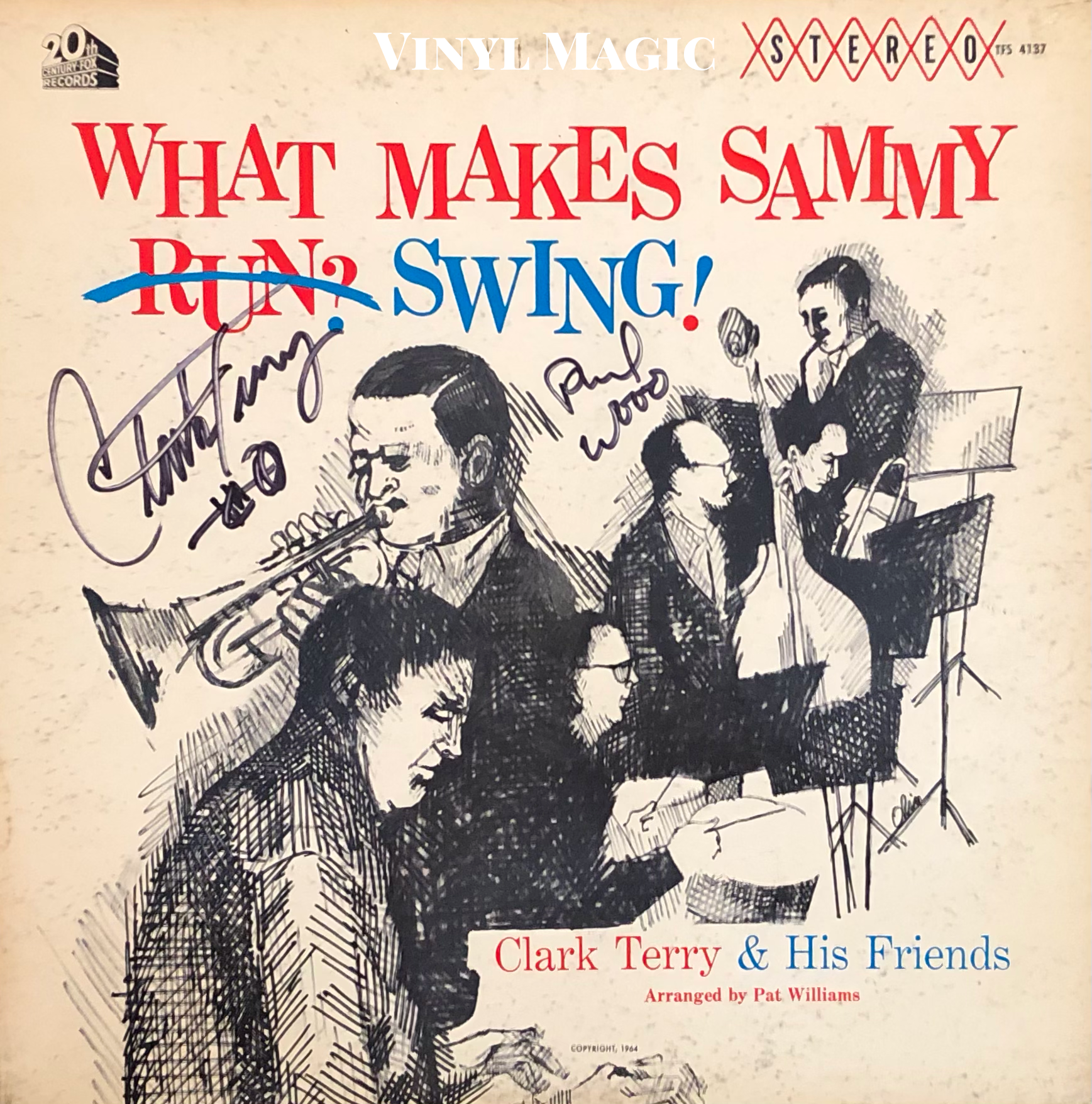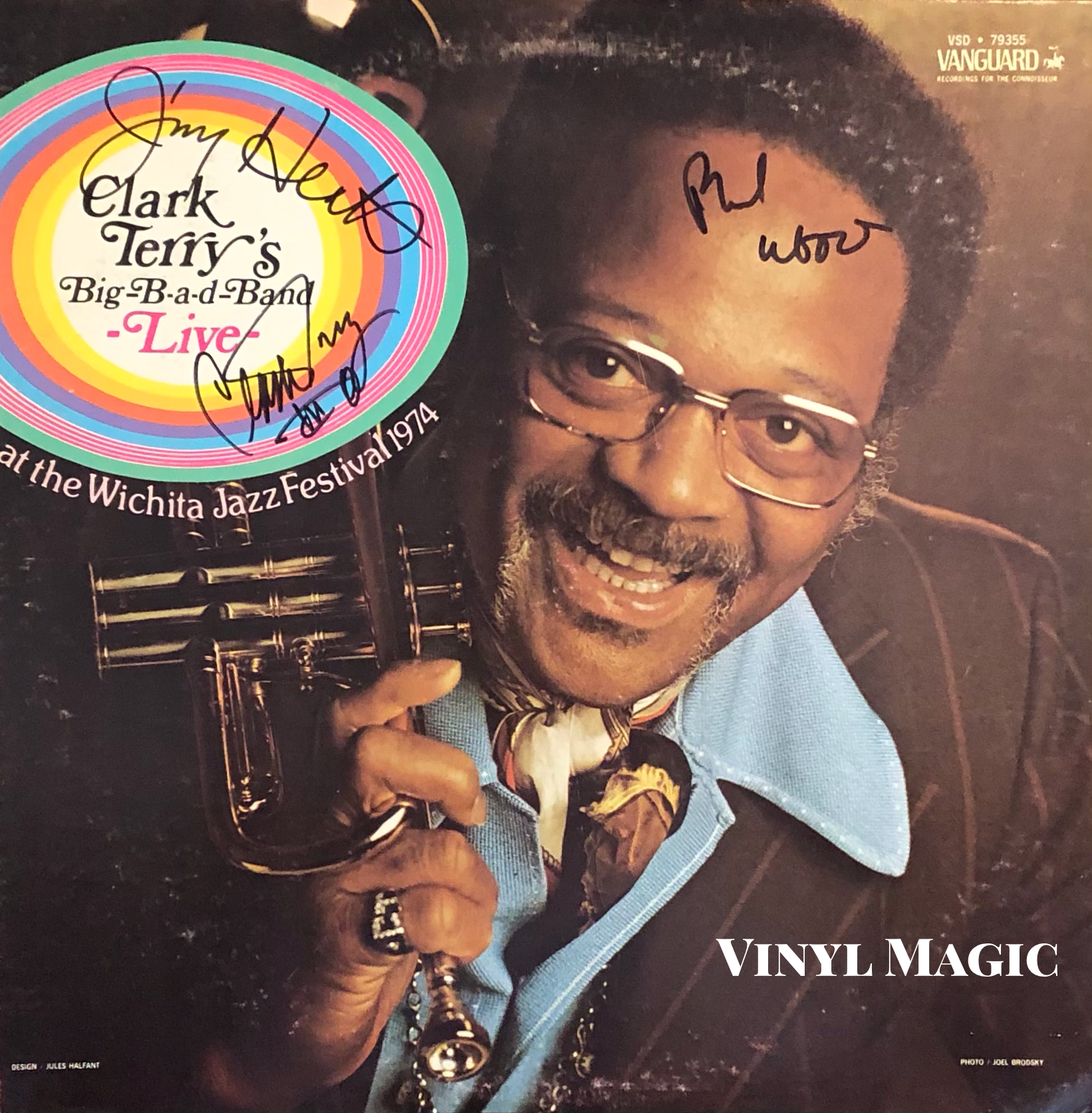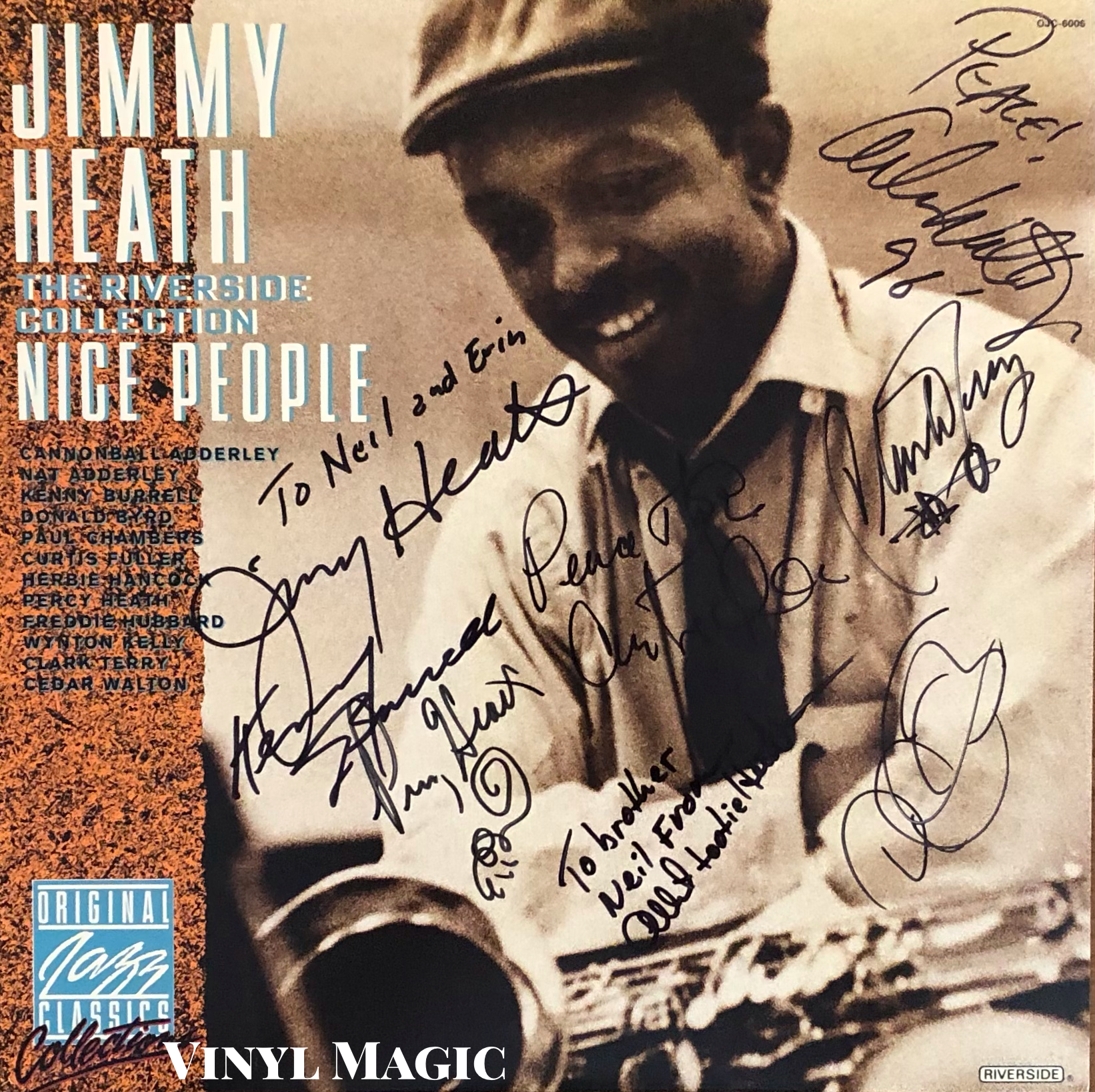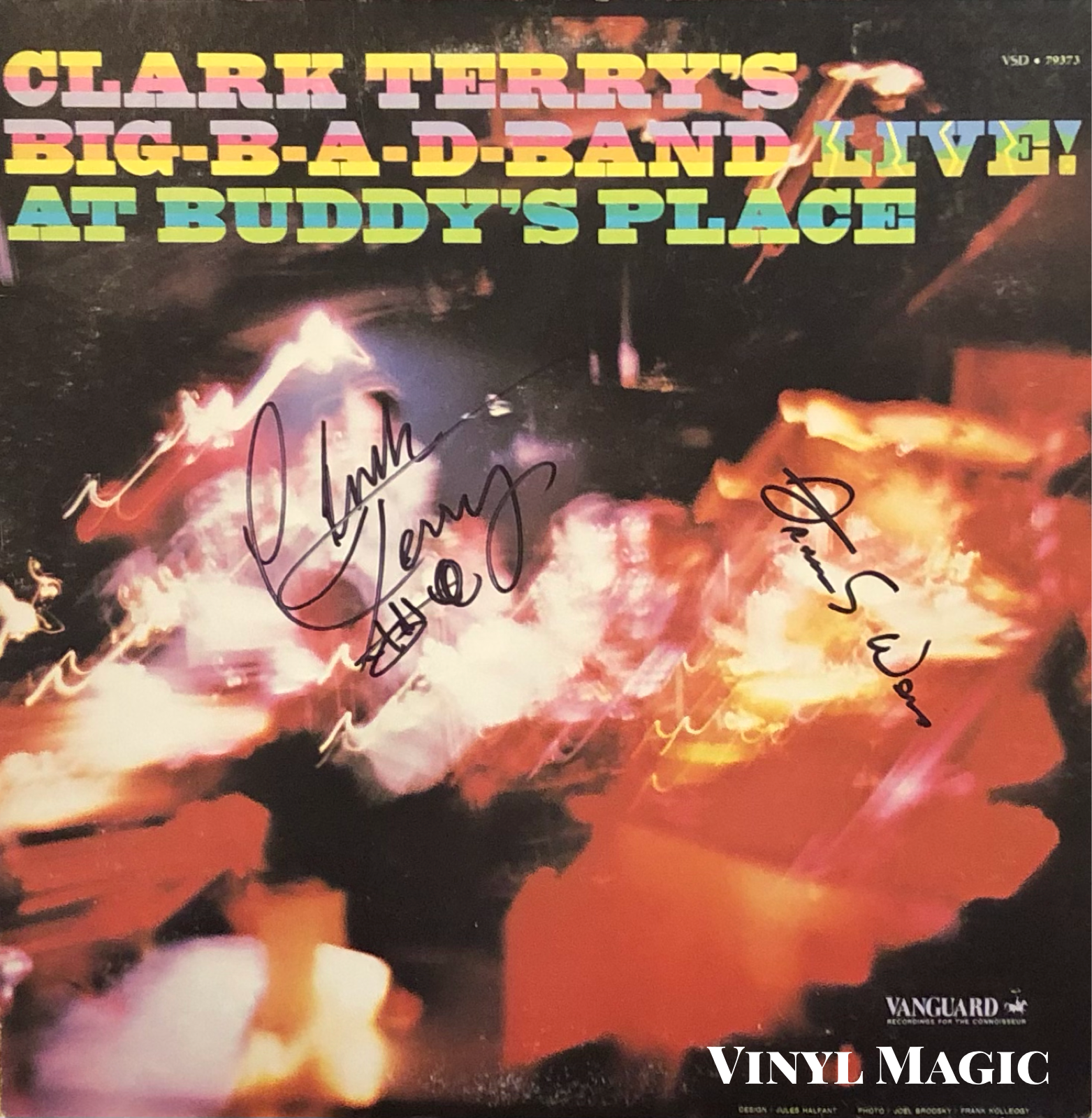Clark Terry and Me…
The first time I ever heard about Clark Terry was when Charlie Barnet told me about him. Charlie was raving: ‘Clark Terry is the greatest trumpet player in the world. You wait and see. Or better still, go get him for your band, but hurry, because soon everybody is going to be trying to get him.’ I considered myself lucky indeed to get him in 1951.
Duke Ellington
Duke With A Difference (1957) signed by Clark
The Happy Horns Of Clark Terry (1964) signed by Clark
The quintessential trumpet player. He can swing. He can bop. He can do anything he wants to do with a horn.
Dizzy Gillespie
In Orbit (1958) signed by Clark
He was the first great jazz trumpeter I had ever heard actually playing live. His spectacular playing made me want to practice (of course) but his warmth and optimism made me want to be a part of the world of jazz.
Wynton Marsalis
It’s What’s Happenin’(1967) signed by Clark
I just like to stay abreast of everything that's going on. A lot of times, it means I have to subsidize my own yen for jazz. I do benefits and small paying gigs, or take a side-man's fee for the sake of someone who needs it more....Being satisfied and just grooving is an unwise thing to do. As the old saying goes, the only difference between a groove and a grave is the dimensions. You can't let the world go by.
Clark Terry 1967 liner notes, It's What's Happenin'
Jam Session (1954) signed by Clark, Maynard Ferguson, Harold Land, Junior Mance, Max Roach
I had a brief foray with the electric trumpet. I was with the Selmer Company. I felt so bad about that because it was teaching young people to rely on a gimmick, but I was being paid to do it and what could I do? I still have the gadget at home in my garage. I look at it with contempt and spit on it occasionally.
Clark Terry
What Makes Sammy Swing! (1963) signed by Clark, Phil Woods
Clark had a way of twisting and lightening the spring action of the pumps of the trumpet, just by adjusting the springs around, that would make your horn sound altogether different. It made your horn sound like magic, man.
Miles Davis on sending all his new trumpets to Clark so that he could fine-tune them
Jazz At The Lyman’s (1965) signed by Clark, Coleman Hawkins, Elvin and Hank Jones, Milt Hinton
Featured on over nine-hundred recordings, Clark Terry was an acclaimed jazz arranger, band leader, composer, educator, mentor and trumpeter. Born in St. Louis, Missouri, Clark grew up poor as the seventh of eleven children. At age ten, already showing a keen interest and an early aptitude for music, Clark constructed his first trumpet, a sheared off section of garden hose attached to a lead pipe mouthpiece with a funnel for a bell. It was a joyful if cacophonous sound. Clark's neighbors became his first benefactors as they pooled their meager resources and scraped $12.50 to buy a used trumpet from the local pawn shop. From such humble origins, a seventy year recording career flourished which spanned generations and included performances before eight U.S. Presidents. Surely, a better $12.50 investment would be hard to find!
Really Big! (1962) signed by Clark, Tommy Flanagan, Jimmy and Albert Tootie Heath
After playing with local bands in and around St. Louis, Clark joined the Count Basie Orchestra in 1948 and stayed for three years before joining Duke Ellington from 1951-1959. As he said, "I learned from Count Basie the importance of the utilization of space and time while playing your solos, which means to not try to play too many notes, but make sure you're swinging. And from Duke Ellington, I learned two rules: Number One, never quit. And Number Two, don't forget rule Number One... I also learned the importance of being musically creative, to keep things interesting."
For Someone I Love (1961) signed by Clark, Milt Jackson, Richard Davis, Hank Jones, Willie Ruff
While studying with Duke at the "University of Ellingtonia", Clark recorded In Orbit in 1958 with Thelonious Monk, the high priest of modern jazz. Showing enormous respect, Thelonious took a sideman's role on the album which featured six Clark Terry compositions, a couple of standards and only one Monk song, "Let's Cool One." It is the only Riverside recording which Thelonious appeared as a sideman. The Monk tune almost didn't happen. Clark explained, "I said, 'Monk, I think it’s about time we recorded one of your tunes.' He didn’t answer, so as I walked away he growled, “Come back here.” He said, “Fine, let’s play this.” He started playing the opening notes to Let's Cool One.He said, “You’ll hear it and then we’ll record it. Just listen.” So I listened and then we recorded it. I had never heard that tune before, and there wasn’t any music. We just did it." Clark also introduced the flugelhorn on this record, one of the first occasions in jazz, and his sound is warm, burnished and mellow, exquisite on the ballads, forlorn on the blues.
Spanish Rice (1966) signed by Clark
Clark's preceding album, Serenade To A Bus Seat, is a 1957 hard bop blowing session which features the powerful saxophone of Johnny Griffin. The title and artwork is compelling. It depicts Clark's trumpet nestled in the back seat of a bus and the liner notes reveal it is a paean to the endless, winding roads that itinerant big band musicians faced in the 1950s. A deeper reflection might suggest the cover is a nod to the Rosa Parks bus seat protest and subsequent Montgomery Bus boycott effected in 1955, a defining moment in the civil rights movement. Clark maintained it was never intended as such a tribute, "a photographer was supposed to come over and take my picture for the album, but he never showed up, and I didn’t have time after that. So they just took a picture of my horn on a bus seat and put that on the cover and used the title for the album." A rather prosaic explanation, nevertheless, the cover retains a potent image and a reminder of the struggles.
Tijuana Jazz (1965) signed by Clark, Bob Brookmeyer
In 1960, Clark joined his one time protégé, Quincy Jones. and they recorded Big Band Bossa Nova which included the hit "Soul Bossa Nova." Quincy recalled, "Clark Terry was my first trumpet teacher as a teen in Seattle, my idol and my brother. When he left the Basie and Ellington bands, also two of my idols, to join mine, (it) was one of the most humbling moments in my life." "Soul Bossa Nova" later became well known as the theme in the Austin Powers film series, a judicious blend of soul meets jazz meets hipsters!
You Better Know It!!! (1964) signed by Clark, Lionel Hampton, Milt Hinton, Hank Jones
Clark Terry was also a pioneer. In 1962, he joined The Tonight Show with Johnny Carson band as first trumpet, the first African American member. Clark understood the pressures, "We had to be models, because I knew we were in a test. We couldn’t have a speck on our trousers. We couldn’t have a wrinkle in our clothes. We couldn’t have a dirty shirt." He remained with Johnny Carson for a decade although, when the Tonight Show decamped to Los Angeles in 1972, Clark chose to remain in New York. A highlight of the show was the "Stump The Band" segment in which members of the studio audience would attempt to stump the band with obscure song titles. Invariably, Clark would accept the challenge and bluff his way through a song, making up the melody and lyrics as he proceeded. These improvisatory experiences helped Clark record "Mumbles", an unlikely hit with pianist Oscar Peterson in 1964. They had finished the session with plenty of time to spare, and Clark started improvising and scatting his way through a dirty, filthy blues vamp. He told Oscar that, "I'd like to sing it like a lot of the old timers used to sound when they were singin' the blues in my hometown in St. Louis...I mean the foot pattin', the sawdust on the floor was bouncin', fingers poppin' and as Ellington would say, "The earlobe jilting"...that was all that mattered…how you sing about whatever you were singin' about didn't matter at all. So that was my put on of the old blues singers." When they were finished recording, Oscar loved "Incoherent Blues" and "Mumbles" and insisted both were on the vinyl release (tracks 5 and 10). "Mumbles" became a surprise hit and, thereafter, a staple in Clark's performances.
Big Bags (1962) signed by Clark Ron Carter, Jimmy Heath, Hank Jones, Milt Jackson, James Moody, Jerome Richardson, Willie Ruff, Doc Severinsen
I saw Clark Terry a dozen or more times in New York City clubs like the Blue Note, The Iridium and The Village Vanguard. He was irrepressible, impossibly exuberant and full of good cheer, the love he had for his music and fellow musicians radiated on and off stage. His shows were a complete jazz education as he imparted the blues he learned from Basie with the elegant swing of Ellington and the knotty dissonance of Monk. And he growled, mumbled, slurred and sang his ass off!
Summit Meeting (1976) signed by Clark, Elvin Jones, James Moody
Just a few highlights from my many interactions through the years: as Clark signed It's What's Happenin', his ill-conceived electric trumpet flop, he acknowledged, "This is not my favorite album!" When he signed, Wham on the front cover, he noticed that the signature blended in with the faux Andy Warhol portraits. He flipped it over and signed the back, "Now, we got both sides covered," he said brightly. "This album launched my singing career," he said as he held Oscar Peterson Trio Plus One. The Duke With A Difference vinyl held special significance as it was recorded with the inestimable piano talents of Billy Strayhorn, Duke's right hand man, arranger and composer of Duke's theme, "Take The 'A' Train", "Man, I loved recording this album, Billy was a beautiful cat, and there's nothing finer than Duke Ellington!"
Oscar Peterson Trio + One (1964) signed by Clark, Oscar Peterson, Ray Brown, Ed Thigpen
There was no one finer than Clark Terry. Miles Davis called him, "My idol on the instrument." Quincy Jones said, "Nobody played like him. I saw him for the first time when I was about thirteen. Just joy, pure joy." Clark was a teacher, mentor and friend to countless others. Duke Ellington once defined the jam session, " It was a cutting session, pure and simple. You established your supremacy over your fellow musicians so that everyone knew you were The Man."
Everyone knew Clark Terry was The Man. He was joy, pure joy.
Wham (1976) signed by Clark
Wham back cover signed by Clark
The Trumpet Kings (1974) signed by Clark, Harry Sweets Edison
Big Bad Band Live (1975) signed by Clark, Jimmy Heath, Phil Woods
Oscar Peterson & Clark Terry (1972) signed by Clark, Oscar Peterson
Around The World (1961) signed by Clark, Phil Woods
Choice Clark Terry Cuts (per BKs request)
https://www.youtube.com/watch?v=qf6_mRGOn2s
“Mumbles" with Oscar Peterson Trio Plus One 1964
https://www.youtube.com/watch?v=oor9PHh9flQ
“In A Mellow Tone" Clark Swings Duke with Tonight Show Orchestra 1965
https://www.youtube.com/watch?v=TFyvfXVDNrs
“Soul Bossa Nova" Clark and Quincy Swing 1962
https://www.youtube.com/watch?v=RRGhG35gBOA
“Let's Cool One" Clark and Thelonious 1958 In Orbit
https://www.youtube.com/watch?v=-ehKgEHp_ao
“Blues For Smedley" Live 1965 in Finland with Oscar Peterson, Ray Brown, Ed Thigpen
https://www.youtube.com/watch?v=ldYen3sYVUc
“Moanin'" Live with Quincy Jones Orchestra 1960
https://www.youtube.com/watch?v=_0RVManL_TM
"Straight No Chaser" Clark Swings Monk with Bob Brookmeyer live 1965
https://www.youtube.com/watch?v=STYdkltUzVc
"Serenade To A Bus Seat" Clark and Johnny Griffin 1957
https://www.youtube.com/watch?v=Z7XtoV9Lv7g
“Take The 'A' Train" Clark Swings Ellington's Theme written by Billy Strayhorn 1980
Happenings (1967) signed by Clark, Hank Jones
The Big Soul Band (1962) signed by Clark, Johnny Griffin, Bob Cranshaw, Harold Mabern, Norman Simmons, Julian Priester
Nice People (1954 recordings, 1988 reissue) signed by Clark, Donald Byrd, Jimmy, Percy, and Albert Tootie Heath, Kenny Burrell, Curtis Fuller, Cedar Walton
Quincy Jones Explores The Music Of Henry Mancini (1964) signed by Clark, Gary Burton, Phil Woods
The Trumpet Summit (1980) signed by Clark
Live At Buddy’s Place (1976) signed by Clark, Frank Wess
Clark Terry And His Jolly Giants (1973) signed by Clark
The Globetrotter (1977) signed by Clark
To Duke And Basie (1986) signed by Clark
The Alternate Blues (1980) signed by Clark
Professor Jiive (1976) signed by Clark
Brahms Lullaby (1978) signed by Clark
Memories Of Duke (1980) signed by Clark
Jazz Galore (1962) signed by Clark, Sarah Vaughan



































